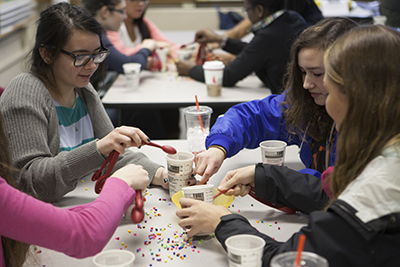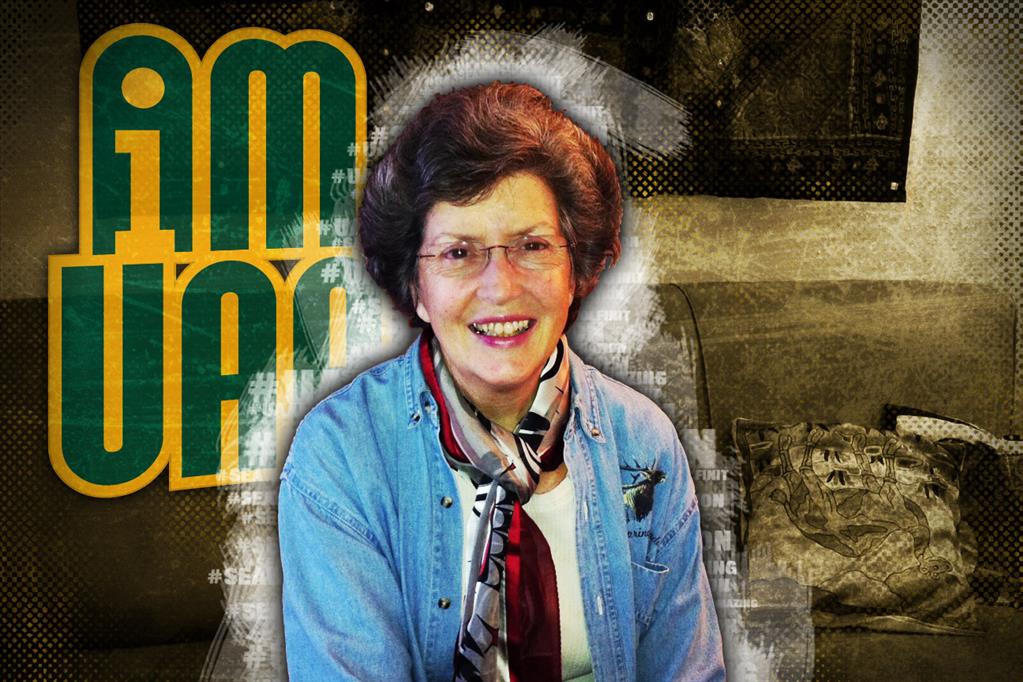Kimura Gallery: 'Healing 1' by Brian Knep, March 27-April 18
by Michelle Saport |
On display: "Healing 1" (2013) by Brian Knep. A single-channel interactive video installation using a computer, video projector, video camera, custom software and vinyl floor. Dimensions variable. Location: Kimura Gallery (Fine Arts Building, Second Floor) Show Dates: Wednesday, March 27-Thursday, April 18 Opening: Wednesday, March 27, 5:30-7:30 p.m. (There is free parking in the Fine Arts Building parking lot after 5:30 p.m.)
"Healing 1" uses custom algorithms to create a glowing pool of organic patterns on the floor. Neon green serves as a backdrop for the red organic modules that mutate on the floor as the spectator interacts with the 10'x16' projection. This work, which is a variation on Brian Knep's Healing Pool series, is unique in terms of conception. Consulting with Knep in Boston, two faculty members in UAA's Department of Art set up the projection system according to his specifications.
The spatial adaptation of the Healing Pool series to different venues is an interesting aspect of this work. One is reminded of Sol Lewitt's "Wall Drawings" that were initiated in 1968 when he developed specifications and/or diagrams for his drawings that were directly applied to walls. Over the years, he produced thousands of drawings using this direct approach. As his series of drawings evolved, he created drawings that were variable in nature regarding their combinatory possibilities. Lewitt provided the specifications to other individuals, allowing them to execute these works at different sites. Once an exhibition ended the wall drawings were destroyed. Physicality leads to ephemerality in this instance.
In Knep's installation there is the element of ephemerality, but it also adds another layer of experience for the individual who interacts with the work. The experience is momentary as individuals involve themselves with creating paths, dislocating the patterns and transposing them on the bodies of individuals in unique ways. When "Healing 1" ends, the "play of lights" and the production will become a memory trace and dissipate in time.
"Healing 1," however, also involves many aspects of the Healing Pool series. As Knep noted in his remarks on the Healing Pool series, "Left alone, the patterns slowly pulsate and shift over the course of each day. When a person walks across the piece the patterns tear apart and rebuild themselves, but never exactly as before. The change is similar to a scar left behind when a wound heals. Thus the pool holds a history, or memory, of all the interactions that have occurred since the piece was first turned on.
This project serves as a type of memorial, a constantly evolving record of change that honors the minuscule ways in which the slightest interactions, no matter how small or unintentional, have some impact. It is also an examination of how each person is, like the pool, a manifestation of everything that came before."
This exhibition is sponsored by the University of Alaska Anchorage's Complex Systems Group and Department of Art.
About Brian Knep: Brian Knep is a media artist working with cutting-edge science and technology. As the artist-in-residence at Harvard Medical School, he works side-by-side with scientists, co-opting their tools and techniques to explore alternative meanings and ways of connecting to the world. Knep's works range from microscopic sculptures for nematodes to large-scale interactive installations. His work has been shown at the RISD Museum, Milwaukee Art Museum, New Britain Museum of Art, McColl Center for Visual Art, Hudson Valley Center for Contemporary Art and others. Knep's "Deep Wounds," commissioned by Harvard University, has won awards from Ars Electronica, the International Association of Art Critics and Americans for the Arts, who selected it as one of the best public-art projects of 2007. He also has grants and awards from Creative Capital, Massachusetts Cultural Council and the LEF Foundation among others.
Knep holds a bachelor's degree in mathematics and computer science and a master's degree in computer science, both from Brown University. He also studied ceramics at the Radcliffe Ceramics Studio and glass blowing at Avon and Diablo Glass. Early in his career he worked as a senior software engineer at Industrial Light & Magic, working on films such as "Jurassic Park," "Mission Impossible" and "Star Trek: Generations." While there, he developed tools including two for which he and three others were awarded technical Academy Awards. Knep also helped found Nearlife, a high-end design and technology company, creating interactive experiences for science and children's museums. His publications have appeared in computer graphics and computer-human interaction journals.
Knep lives and works in Boston and is represented by Ronald Feldman Fine Arts, N.Y. See more work and information regarding Brian Knep at blep.com.
 "Kimura Gallery: 'Healing 1' by Brian Knep, March 27-April 18" is licensed under a Creative Commons Attribution-NonCommercial 4.0 International License.
"Kimura Gallery: 'Healing 1' by Brian Knep, March 27-April 18" is licensed under a Creative Commons Attribution-NonCommercial 4.0 International License.















